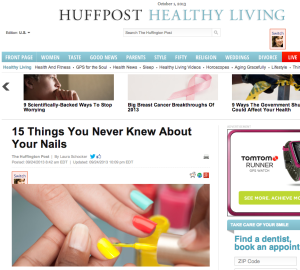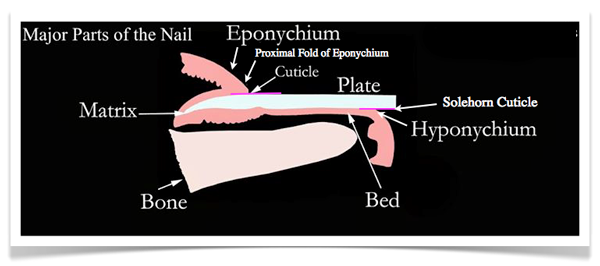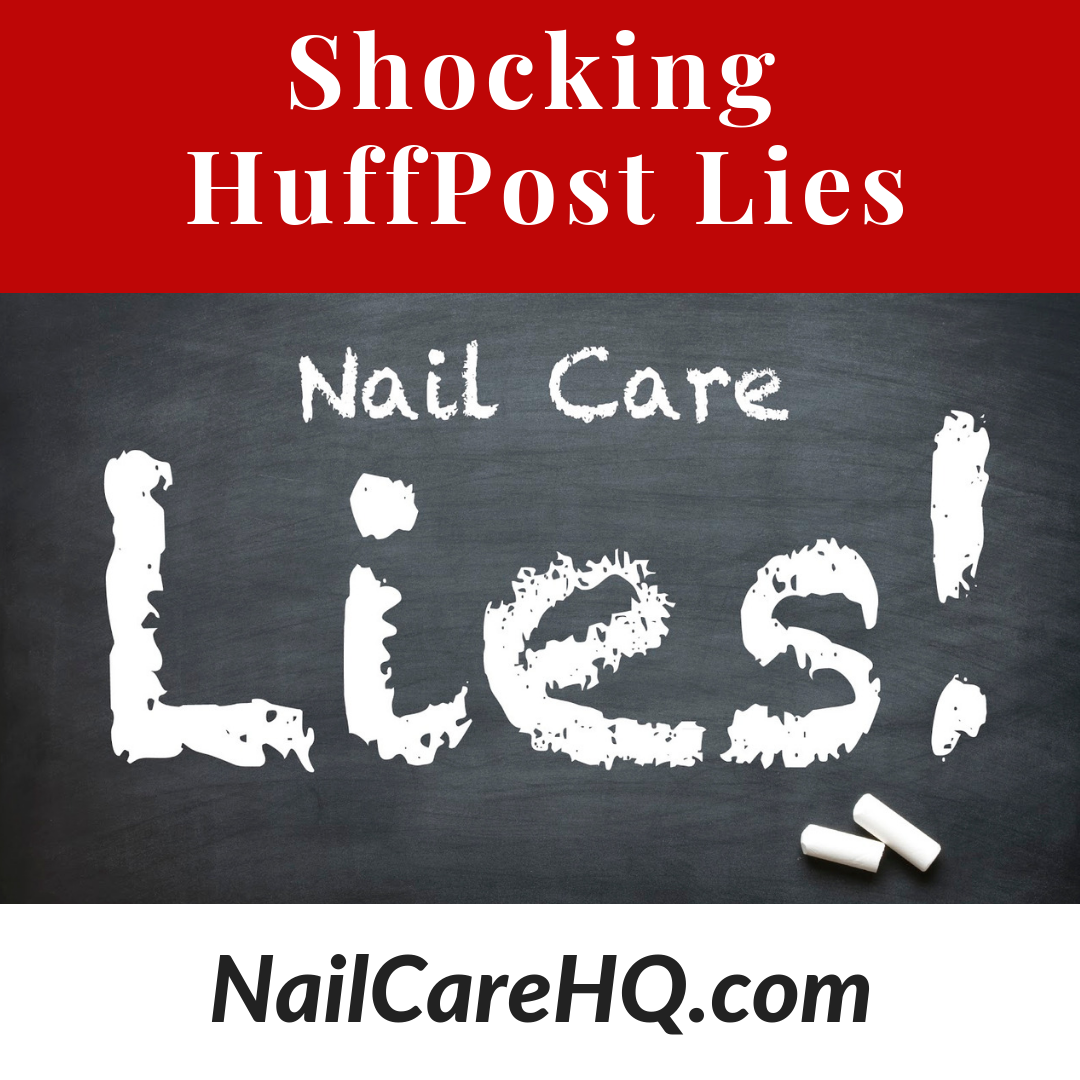By Ana Seidel & Doug Schoon
With so much information on the internet, how do you know who is telling the truth? It’s especially frustrating when respected sources are wrong.
In this article, you’ll learn:
- The four lies that the Huffington Post failed to fact check
- The true effect of acetone and water to the nail plate
- How polish can help keep your nails healthier
Huffington Post Publishes Lies About Nails
Even though I previously wrote an article on this topic, it’s pretty shocking that a well-respected site like the Huffington Post allowed this article written by Senior Editor of Healthy Living, Laura Schocker to actually be published.
In the old days, journalists used to be required to double-check their facts and sources. But today, it appears anyone can write anything and get it published. Instead of the source doing their homework, you the consumer have to do the homework. This is totally backward to me.
Overall, most of the content in Ms. Schocker’s article, 15 Things You Never Knew About Your Nails, is correct, but the following section is riddled with lies.

Advice That Is FALSE!
You actually should let your nails “breathe” between manicures.
You might want to reschedule that weekly mani appointment — according to Krant, it’s best to reduce the amount of time your nails are polished to keep them at their healthiest. “Believe it or not, that hard thing on the tip of your finger is living tissue, and oxygen does penetrate through the nail plate to the nail bed,” she says. “When you smother the nail and the nail bed beneath it, the nail has a harder time fighting off infections like the wart virus or a nail fungus. Also, nail polish is quite drying to the nail, so keeping them polished all the time (and re-doing the manicure repeatedly, with the drying chemicals used to remove polish) can eventually dry them out and make them less flexible and strong.”
~Huffington Post
And apparently, the source for this quote is: Jessica Krant, M.D., a board-certified dermatologist, founder of Art of Dermatology and an assistant clinical professor of dermatology at SUNY Downstate Medical Center in New York City.

Lie #1
As a dermatologist and professor, she should know that the nail plate is about 50 layers of DEAD keratin, not live tissue. This is why we feel no pain when filing or cutting our nails.
Lie #2
Oxygen does NOT penetrate from the outside-in—through the nail plate (hard nail) to the nail bed (soft pink tissue under nail). Doug Schoon, author of Nail Structure and Product Chemistry, explains in more detail.
“Whoever wrote this doesn’t understand the natural nail or nail polish and is only parroting very old myths that have no basis in facts. In other words, this is nonsense! The nail bed is living tissue and it gets 100% of its oxygen from the blood. None comes through the nail plate to the bed.”
Myth 1: Nails Need to Breath.
• No, they don’t! There is no reason to believe that nails need to “breathe”. Nails aren’t alive and don’t have lungs nor do they have any ability to absorb air into the nail plate. This myth makes no sense on many levels! In short, nails do NOT require an external air supply and do not breathe or exhale. 100% of the oxygen needed by the nail matrix to create a new nail plate comes from the blood stream and 0% comes from the outside world.
• Everything the nail plate needs to properly grow and function is delivered and/or removed by the blood flow to the matrix area and nail bed. The matrix is where the nail plate is created from nutrients which can ONLY be delivered by the blood stream. Neither “air” nor “nutrients” can be absorbed or “fed” to the nail plate from any external source.
• Moisture and natural nail oils leave the nail bed and pass through the nail plate at slower than normal rates, but they aren’t “trapped”. The nail plate’s moisture content is increased by 10-15%, and the oil content increases only slightly; both serves to increase the flexibility of the natural nail plate.
• Waste products are removed from the matrix area and surrounding tissues by the blood as well, and are not released into the nail plate. Normal, healthy nail plates would continue to grow and thrive in a completely air-free environment, as long as a healthy flow of blood to the nail is maintained, so clearly… nails don’t need to breathe! ~Doug Schoon. http://schoonscientific.com/…/Myths-from-FB_2013-03-14.pdf
Lie #3
Dr. Krant should also know that nail polish isn’t smothering the nail from oxygen so nail fungus can flourish. Nail fungus flourishes in a nice, dark, moist environment.
This is why nail fungus tends to take hold during the winter months while we keep our feet in shoes or fuzzy slippers all day long. The only way polish would contribute would be the use of dark pigmented polishes during the summer. It keeps that environment dark, and can be worsened if we visit the pool or the beach frequently.
Lie #4
Dr. Krant should also know that lacquer is not drying to the nail plate. I think there is a misunderstanding when using the words “dry” vs “harden”. When you understand that polish actually hardens through evaporation of the solvents, it’s easy to understand that your polish is simply the pigments and resins left behind. No part of the natural nail is getting dried out.
Acetone
Acetone IS the drying culprit, and Dr. Krant did get this one correct. But her advice to stay away from it is completely misguided. There are many things we enjoy in life that come with negative consequences. Dr. Krant’s advice is like telling us to not live (or visit) the desert because we might die of thirst. … bring water!
Since acetone is the best solvent to dissolve polish, it will dissolve your body oil too. The great news is that we now know that acetone’s drying forces can be reversed with several applications of a high quality, jojoba based nail and cuticle oil.
Water
What Ms. Krant doesn’t appear to know is that water and soap is more damaging to the nail plate than polish. As I explain in a previous article, the nail plate has the capability to absorb one third it’s weight in water. Our nails are a little bit like sponges. The water goes in, and then must evaporate out. It can take over 60 minutes for the water to evaporate. During this time, they are very fragile and tear easily.
Think of paper. When it’s full of water, the fibers pull apart with very little force. When the water has evaporated, the paper is able to withstand more forces without tearing. Our nails work in a similar way.
Polish is Our Friend
Nail polish actually protects the nail plate from drying out. Using a complete polish wrap under the tips, helps block excessive water absorption.
The nail bed is constantly pumping a perfect blend of 5% sebum (body oil) and 18% water up into the nail plate. If we rarely washed our hands, our nails would stay flexible and healthy.
But we do wash our hands—on average 20 times per day. Polish can actually protect our nail plate by helping to block water absorption and temporarily trapping our sebum in the nail plate. My favorite technique is the Fab 5 Polish Wrap. Click here for instructions.
In Conclusion
Besides helping us feel prettier, polish is actually helping to keep our nails healthier. Polish adds temporary strength and blocks excessive water absorption. In my world…polish is a very good thing!

Nope, it didn’t change my thoughts as I was 100% with you from the start, reading Dr Krant’s lies (if it weren’t for the brig brand ‘huffpost’, I would’ve suspected that our beloved smartypants dr doesn’t exist at all). Or distortions of the reality, better put, so we don’t upset anyone 😉
But thank you for standing up and fighting the nonsense! Fortunes were made based on myths and chain-email ‘facts’. Maybe it’s time we smarten up and get a slice of it. Like a fee for truth 😉
An interesting theory Kpriss! You may be “spot on”.
Thank you so much for the words of encouragement! They spur me on when writing.
I really appreciate you taking the time to stop by and leave a comment! <3
thanks for that info, i wonder how people can say things like that and he is dermatologist !! 🙁 sad
It is frustrating Anita. Thanks for stopping by! ~Ana
My blood boiled too when I read their article! I was not even able to comment because of so many inaccuracies! Good for you for setting them straight!! A very well written article, thank you so much for posting!!
Thank you so much for your kind words Tina!
Ana – you are such a great source of reliable information!! I have been using your oil for two weeks and I will be sure to write a review for you and on my blog. Amazing! I already ordered more pens and refills; those pens are the best!! I can apply the oil anywhere (and do!).
Thank you so much Elizabeth! Please send me the link to your post and I’ll share it. <3 ~Ana
Oh My Gosh! I wish I had read this article last night when I was being told off on Instagram for painting my nails to Often!!! Ha! I know where Ill send them all next time! I personally have noticed the health and strength of my nails improved 1000 times over since I started painting my nails everyday and using oils and hand creams..They no longer peel or crack at all! So I think I am absolute Proof that painting your nails is Good for them!
Thank you for This!! Im sure its going to save me from pulling my hair out answering Questions like “doesn’t painting your nails so often damage them?” …. 😛
Regards
Tam
@ohmygoshpolish
Refinery29 published a similar article with false information. I commented and directed people to your site, so hopefully they can get the correct information they need!
This is a great article! Thank you.